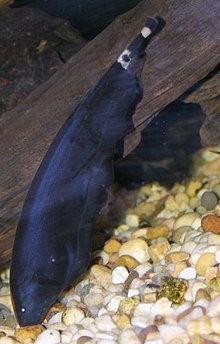User:CSTAtester/sandbox
| Gymnotiformes Temporal range: [1]
| |
|---|---|

| |
| Black ghost knifefish, Apteronotus albifrons | |
| Scientific classification | |
| Kingdom: | |
| Phylum: | |
| Class: | |
| Order: | Gymnotiformes
|
The Gymnotiformes are a group of teleost bony fishes commonly known as the Neotropical or South American knifefishes. They have long bodies and swim using undulations of their elongated anal fin. Found exclusively in fresh water, these mostly nocturnal fishes are capable of producing electric fields for navigation, communication, and, in the case of the electric eel (Electrophorus electricus), attack and defense. A few species are familiar to the aquarium trade, such as the black ghost knifefish (Apteronotus albifrons), the glass knifefish (Eigenmannia virescens), and the banded knifefish (Gymnotus carapo).
Description
[edit]Aside from the electric eel, gymnotiformes are slender fish with narrow bodies and a tapering tail, hence the common name of "knifefishes". They have no pelvic fins or dorsal fin, but do possess a greatly elongated anal fin that stretches along almost the entire underside of the body. The fish swim by rippling this fin, keeping their bodies rigid. This means of propulsion allows them to move backwards as easily as they move forwards.[2]
The caudal fin is absent or, in the apteronotids, greatly reduced. The gill opening is restricted. The anal opening is under the head or the pectoral fins.[3]
These fish possess electric organs that allow them to produce electricity. In most gymnotiforms, the electric organs are derived from muscle cells. However, in adult apteronotids they are derived from nerve cells (spinal electromotor neurons). The electric discharge is continuous, being generated day and night throughout the entire life of the individual. Certain aspects of the electric signal are unique to each species, especially a combination of the pulse waveform, duration and repetition rate.[4]
The electric organs of most gymnotiformes produce tiny discharges of just a few millivolts, far too weak to cause any harm to other fish. Instead, they are used to help navigate the environment, including locating the bottom-dwelling invertebrates that compose their diet. They may also be used to send signals between fish of the same species. In addition to this low level field, the electric eel also has the capability to produce much more powerful discharges to stun prey.[2]
Taxonomy
[edit]There are currently about 150 known species in 32 genera contained in 5 families, and at least 50 or so additional species are known and are yet to be formally described[5]. The actual number of species in the wild is unknown[6]. This group is thought to be the sister group to the Siluriformes[7] from which they diverged in the Cretacous Period (about 120 million years ago).
The families are classified over suborders and superfamilies as below.[8]
Order Gymnotiformes
- Suborder Gymnotoidei
- Family Gymnotidae (banded knifefishes and electric eel)
- Suborder Sternopygoidei
- Superfamily Rhamphichthyoidea
- Family Rhamphichthyidae (sand knifefishes)
- Family Hypopomidae (bluntnose knifefishes)
- Superfamily Apteronotoidea
- Family Sternopygidae (glass and rat-tail knifefishes)
- Family Apteronotidae (ghost knifefishes)
- Superfamily Rhamphichthyoidea
Distribution and habitat
[edit]Gymnotiform fishes inhabit freshwater rivers and streams throughout the humid Neotropics, ranging from Guatemala to Northern Argentina. They are nocturnal fishes. The families Gymnotidae and Hypopomidae are most diverse (numbers of species) and abundant (numbers of individuals) in small "terra-firme" (non-floodplain" streams and rivers, and in floodplain "floating meadows" of aquatic macrophytes (e.g., Eichornium, the Amazonian water hyacinth). Apteronotidae and Sternopygidae are most diverse and abundant in large rivers. Species of Rhamphichthyidae are moderately diverse in all these habitat types.
Evolution
[edit]Gymnotiformes are among the more derived members of Ostariophysi, a lineage of primary freshwater fishes. They arose in the western portion of Gondwana in what is now South America before the geological separation with Africa about 120 million years ago. The only known fossils are from the Miocene about 7 million years ago of Bolivia[9].
Gymnotiformes has no extant species in Africa. This may be because they did not spread into Africa before South America and Africa split, or it may be that they were outcompeted by mormyrids, which are similar in that they also use electrolocation.[5].
See also
[edit]References
[edit]- ^ Froese, Rainer; Pauly, Daniel (eds.). "Order Gymnotiformes". FishBase. Apr 2007 version.
- ^ a b Ferraris, Carl J. (1998). Paxton, J.R. & Eschmeyer, W.N. (ed.). Encyclopedia of Fishes. San Diego: Academic Press. pp. 111–112. ISBN 0-12-547665-5.
{{cite book}}: CS1 maint: multiple names: editors list (link) - ^ Albert, J.S. 2001. Species diversity and phylogenetic systematics of American knifefishes (Gymnotiformes, Teleostei). Misc. Publ. Mus. Zool. University of Michigan, 190:1-127.
- ^ Crampton, W.G.R. and J.S. Albert. 2006. Evolution of electric signal diversity in gymnotiform fishes. Pp. 641-725 in Communication in Fishes. F. Ladich, S.P. Collin, P. Moller & B.G Kapoor (eds.). Science Publishers Inc., Enfield, NH.
- ^ a b Albert, J.S., and W.G.R. Crampton. 2005. Electroreception and electrogenesis. Pp. 431-472 in The Physiology of Fishes, 3rd Edition. D.H. Evans and J.B. Claiborne (eds.). CRC Press.
- ^ Albert, J.S. and W.G.R. Crampton. 2005. Diversity and phylogeny of Neotropical electric fishes (Gymnotiformes). Pp. 360-409 in Electroreception. T.H. Bullock, C.D. Hopkins, A.N. Popper, and R.R. Fay (eds.). Springer Handbook of Auditory Research, Volume 21 (R.R. Fay and A. N. Popper, eds). Springer-Verlag, Berlin.
- ^ Fink and Fink, 1996
- ^ Nelson
- ^ Albert, J.S. and W.L. Fink. 2007. Phylogenetic relationships of fossil Neotropical electric fishes (Osteichthyes: Gymnotiformes) from the Upper Miocene of Bolivia. Journal Vertebrate Paleontology 27(1):17-25.
